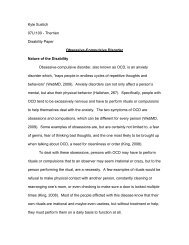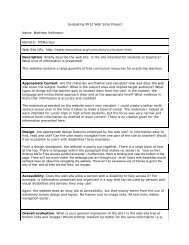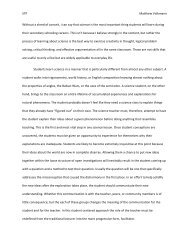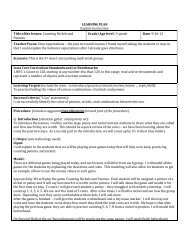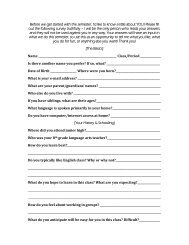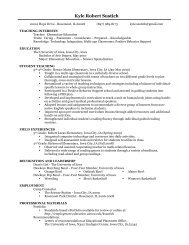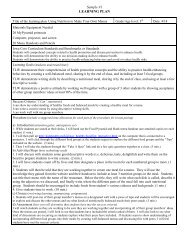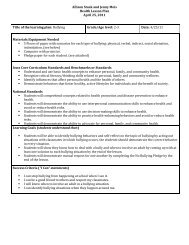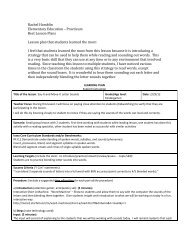Writing child study - Employment
Writing child study - Employment
Writing child study - Employment
Create successful ePaper yourself
Turn your PDF publications into a flip-book with our unique Google optimized e-Paper software.
ut also be very difficult and frustrating for others. One way to start off with thinking about a topic would be to have<br />
the students write a list of things they like a lot or think they are experts on in their writing journals. Buckner<br />
proposes, “This is an easy, reasonable task even for students who struggle as writers. It is a strategy that can be used<br />
again and again for generating idea topics” (2007, p. 19). Buckner also explains that this can be a strategy that can be<br />
used to think deeper about the topic in the revision stage. The next phase of the writing process would be to draft! This<br />
is where they will write their first draft of their story. I will encourage them to use invented spelling so they don’t<br />
concentrate on how to spell words because I know that takes away from the fluency of their writing and might cause<br />
them to forget some of the ideas they have in their heads.<br />
The next thing I would do with my students would be to work on character development. Fletcher & Portalupi has<br />
several fantastic ways to work on developing characters. They say, “Perhaps the easiest way for young writers to<br />
begin developing the characters in their writing is to attend to the physical traits of those characters” (2007, p. 46). I<br />
would read them a story and have them make a list of the physical traits that come to mind from the story. Then, by<br />
looking at how detailed the list they made about the story I read to them was have them try to write a very descriptive<br />
paragraph about their character/characters that they can include into their story. My next mini lesson would be to<br />
incorporate Buckner’s exercise for writing strong grabber leads. I would have them write 5-10 different ways to say<br />
the first sentence of the story that they think will grab the reader’s attention. Then, they would pick the one they like<br />
the best. The next mini lesson I would do would be to help my students understand how stories have a beginning,<br />
middle, and an end. Fletcher & Portalupi explain that a good story had a beginning, middle, and an end. To explain<br />
this concept, I would read a story to them and have them try to guess what the beginning was, the middle, and the end.<br />
Then, I would have them write their own beginning, middle, and end for their stories. I realize this might be a tough<br />
concept for younger students to grasp and if they don’t seem to be getting it, I would do separate mini lessons on each<br />
the beginning, middle, and end.<br />
The next stage would be conferencing. This would take place with me or with peers. They would meet with me for<br />
around 7-10 minutes (or however much time works within our writing time). While I’m conferencing with students<br />
they will be conferencing with peers. Every time I change students they will too. They will switch 3 times and then<br />
continue on with silent reading.<br />
For the revision stage I would concentrate on adding detail. I agree with Fletcher & Portalupi when they suggest,<br />
“Young students often draw the main elements of their stories without situating them in a larger context” (2007, p.<br />
43). For instance, a student’s story is about someone who broke their leg and they draw a picture of a person with a<br />
broken leg. From this drawn person, we see nothing but the main character and an empty landscape. I would sculpt my<br />
mini lesson about using details to describe setting a little differently than Fletcher & Portalupi do. I would use my<br />
hypothetic student’s example of a person who broke their leg and draw a picture of just that student with a broken leg.<br />
Then draw another picture of that same students and his/her broken leg but put them lying beneath monkey bars on the<br />
playground. Then I would ask the student how the second picture tells them more about what’s happening in the<br />
picture. After that, I would have them each draw a picture of something happening to their main character and tell<br />
them to make a strong background scene. After they have a picture, I would have them write a paragraph about their<br />
picture explaining what is happening and then they can include it into their story. This will also come in handy when<br />
their work gets published in the room and they already have artwork to go along with their story. The next thing I<br />
would have them work on would be adding dialogue to their writing. Using Fletcher & Portalupi’s lesson on getting<br />
your characters talking, I would have them listen to me read an excerpt of dialogue and have them make a chart. On<br />
one side it would be what they learned about the character and the other side would show what piece of dialogue<br />
showed them that. By seeing this side by side comparison it will really help them see how dialogue strengthens a<br />
story. Then I will have them work on adding dialogue into their own stories.<br />
Conferencing again.<br />
The nest stage is the editing stage. To address spelling I will do a strategy from Buckner that has to do with reading<br />
backwards. I will have them read their stories backwards and circle the words they think are spelled wrong or think<br />
are spelled wrong. Then I will have a spelling workshop they would use different ways to find the correct spellings.<br />
One would be to use books they have in their desks and have them try to find that same word in the text to find the<br />
correct spelling for it (Buckner, 2005). Another thing I would do would have them keep personal dictionaries like I<br />
had in grade school along with a word wall I would have posted in the classroom. This personal dictionary will have<br />
words they have previously spelled wrong in pieces of writing, word wall words, or any other word we as a class





